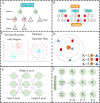Applications of flexible materials in health management assisted by machine learning
- PMID: 40599562
- PMCID: PMC12208289
- DOI: 10.1039/d5ra02594j
Applications of flexible materials in health management assisted by machine learning
Abstract
In recent years, the demand for improved health management has become increasingly higher; however, the existing medical resources have made it difficult to meet this demand. The field of health management is in urgent need for self-help monitoring equipment, intelligent identification technology and personalized medical services. This article reviews the application of flexible materials in health management, particularly the application of flexible wearable sensing devices combined with machine learning technology in various medical scenarios, and classifies them into several types of applications such as health monitoring and prevention, disease diagnosis and treatment, rehabilitation treatment and assistance. Flexible materials can be used to fabricate or integrate various types of high-sensitivity sensors with the characteristics of high flexibility and self-adhesion, resulting in a wealth of health monitoring equipment. These devices can self-monitor various physiological indicators in various parts of the human body. The integration of machine learning (ML) makes it possible to analyze and identify subtle, massive, multi-channel and multi-modal sensor data, accelerating the intelligent process of health management and personalized medicine. This paper not only elaborates on various flexible materials and ML algorithms commonly used in the field of health management, but also focuses on discussing the application of ML-assisted flexible materials in different stages of health management, and puts forward prospects for the future development direction, providing reference and inspiration for major changes in the field of health management.
This journal is © The Royal Society of Chemistry.
Conflict of interest statement
The authors declare no conflict of interest.
Figures





Similar articles
-
Home treatment for mental health problems: a systematic review.Health Technol Assess. 2001;5(15):1-139. doi: 10.3310/hta5150. Health Technol Assess. 2001. PMID: 11532236
-
Cauliflower leaf diseases: A computer vision dataset for smart agriculture.Data Brief. 2025 Apr 28;60:111594. doi: 10.1016/j.dib.2025.111594. eCollection 2025 Jun. Data Brief. 2025. PMID: 40534720 Free PMC article.
-
Assessing the comparative effects of interventions in COPD: a tutorial on network meta-analysis for clinicians.Respir Res. 2024 Dec 21;25(1):438. doi: 10.1186/s12931-024-03056-x. Respir Res. 2024. PMID: 39709425 Free PMC article. Review.
-
Advancements in AI based healthcare techniques with FOCUS ON diagnostic techniques.Comput Biol Med. 2024 Sep;179:108917. doi: 10.1016/j.compbiomed.2024.108917. Epub 2024 Jul 25. Comput Biol Med. 2024. PMID: 39059212 Review.
-
Perceptions and experiences of the prevention, detection, and management of postpartum haemorrhage: a qualitative evidence synthesis.Cochrane Database Syst Rev. 2023 Nov 27;11(11):CD013795. doi: 10.1002/14651858.CD013795.pub2. Cochrane Database Syst Rev. 2023. PMID: 38009552 Free PMC article.
References
-
- Chen Q. Zhao Y. Liu Y. Current Development in Wearable Glucose Meters. Chin. Chem. Lett. 2021;32:3705–3717.
-
- Zhou X. Wearable Health Monitoring System Based on Human Motion State Recognition. Comput. Commun. 2020;150:62–71.
Publication types
LinkOut - more resources
Full Text Sources

